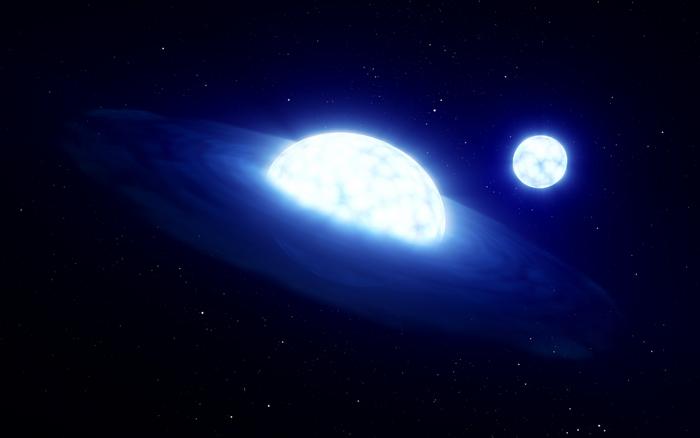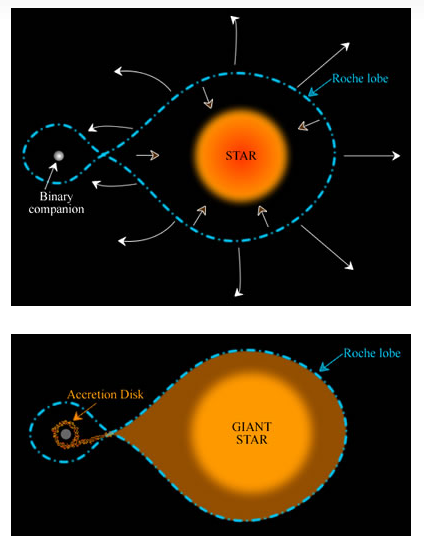'Odd couple' kissing stars created by unromantic cannibalistic feeding dance
The discovery reveals the origins of rapidly spinning "Be" stars and their tiny subdwarf companions. Valentine's Day won't be all hearts and flowers for some "kissing stars"

Valentine's Day won't be all hearts and flowers for some "kissing stars" — or, in other words, stars that exist in close binaries that have been locked in a waltz that has left one a shrunken husk, and the other a swollen orb.
Astronomers have zoomed in on a group of such "odd couple" stars, only to discover the bodies appear to have been created by a voracious and essentially cannibalistic stellar feeding process. How unromantic.
The team, led by Georgia State Postdoctoral Research Associate Robert Klement, used the Center for High Angular Resolution Astronomy (CHARA) telescope array to study spinning stars known as B-emission line stars, or Be stars, spotting faint light patterns coming from tiny orbiting stripped stars, known as "subdwarfs."
Related: Dead 'vampire' star is feeding on a companion and firing out cosmic cannonballs
Investigating these massive stars with the CHARA Array telescopes has revealed how both subdwarf stars and Be stars are created, thus shedding light on a stage in the lives of binary stars that has long been shrouded in mystery.
"The CHARA Array survey of the Be stars has revealed directly that these stars were created through a wholesale transformation by mass transfer," Douglas Gies, director of the CHARA Array, said in a statement. "We are now seeing, for the first time, the result of the stellar feast that led to the stripped stars."
When binary stars get too close
Be stars are believed to form as a result of intense interactions between stellar partners in particularly close binary systems, especially when one of those stars is particularly massive.
Breaking space news, the latest updates on rocket launches, skywatching events and more!
Stars in binary systems exist in mathematically defined, adjoined pear-shaped "lobes" called Roche lobes. As massive stars age, they can swell out and fill in their Roche lobe. When this happens, the stars "kiss" as material from the lobe-filling "donor star" begins to pass to the other one. This stellar material travels through a mid-point where the lobes meet, and forms a disk around the feasting star, called an accretion disk, from which material gradually falls to the stellar surface.
This mass-transfer, cannibalistic process continues until it has stripped the donor star of almost all of its outer plasma layers, transforming it into a tiny hot core: A subdwarf star.
This isn't the only consequence of the feeding process, however. Matter stripped from the donor star carries with it angular momentum, a force that's also fed to the cannibal star.
This causes the feeding star's rotation to speed up, and means these stars spin incredibly fast. Indeed, massive Be stars are some of the most rapidly rotating stars ever seen; some rotate so fast they fling material away from their equators. Over time, this material even manages to gather in a disk around them.
Stripped subdwarf stars that have fed Be stars are difficult to see in their stripped state because they are so close to these massive stars. Their faint emissions are overwhelmed by the bright emissions of their cannibalistic companions.
The six telescopes of Georgia State's CHARA Array on Mount Wilson's summit allowed astronomers to see these faint, striped stars because, as these 'scopes act together as a single 330-meter wide telescope, they can separate the light from binary stars even when the stars are exceptionally close together.
The team also used the MIRC-X and MYSTIC cameras, built at the University of Michigan and at Exeter University in the U.K., both capable of recording both faint and bright light emissions from an object that's in close proximity.
The aim of this two-year investigation was to discover if the transfer of matter to Be stars had indeed accelerated their rotation.
Around nine of the 37 Be stars the team studied indicated faint light characteristic of stripped stars. The team honed in on seven of these targets to better determine the orbits of these stripped components as they orbit the more massive Be stars. This revealed just how drastic the feeding process that creates these very different stars is.
"The orbits are important because they allow us to determine the masses of stellar pairs," Klement said. "Our mass measurements indicate that stripped stars lost almost everything. In the case of the star HR2142, the stripped star probably went from 10 times the mass of the sun down to about one solar mass."
Not all of the Be stars targeted by the team seem to be orbited by a stripped subdwarf star, however, as the team suspects that is because these missing stars have transformed into white dwarfs and are now far too faint to be seen.
Klement will soon extend the search for these odd couples of little and large stars to the southern horizon over Earth using the Very Large Telescope in the Atacama Desert of Northern Chile. He will also turn to the Hubble Space Telescope to further examine ultraviolet light from the hot subdwarfs.
"This survey of Be stars — and the discovery of nine faint companion stars — truly demonstrates the power of CHARA," Alison Peck, program director in the National Science Foundation’s Astronomical Sciences Division, which supports the CHARA Array, said. “Using the array's exceptional angular resolution and high dynamic range allows us to answer questions about star formation and evolution that have never been possible to answer before."
The team's research was published in February in The Astrophysical Journal.

Robert Lea is a science journalist in the U.K. whose articles have been published in Physics World, New Scientist, Astronomy Magazine, All About Space, Newsweek and ZME Science. He also writes about science communication for Elsevier and the European Journal of Physics. Rob holds a bachelor of science degree in physics and astronomy from the U.K.’s Open University. Follow him on Twitter @sciencef1rst.

